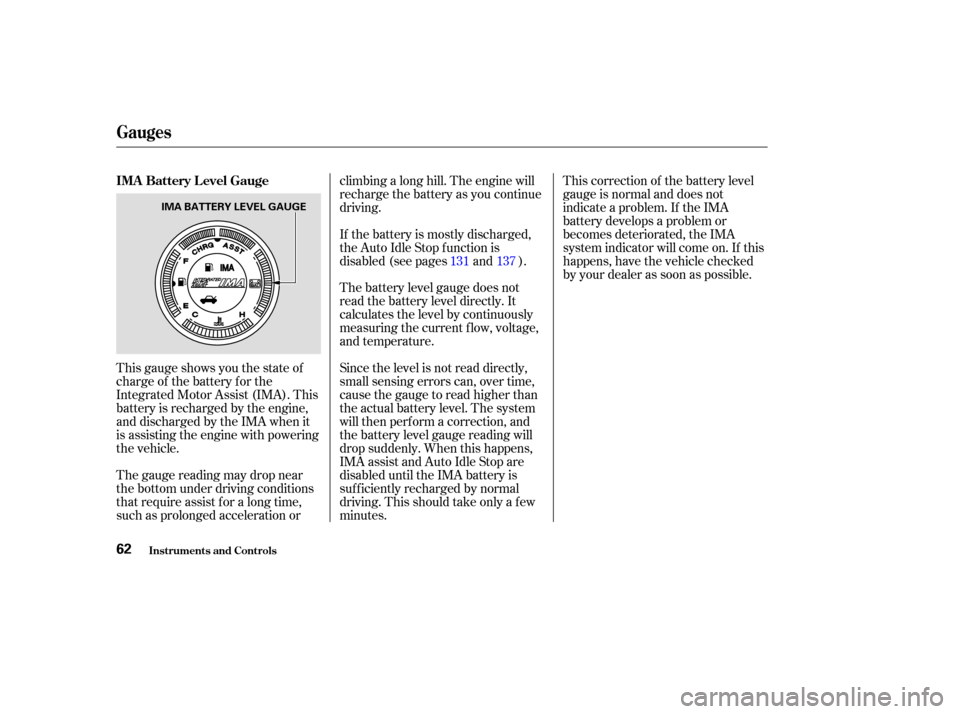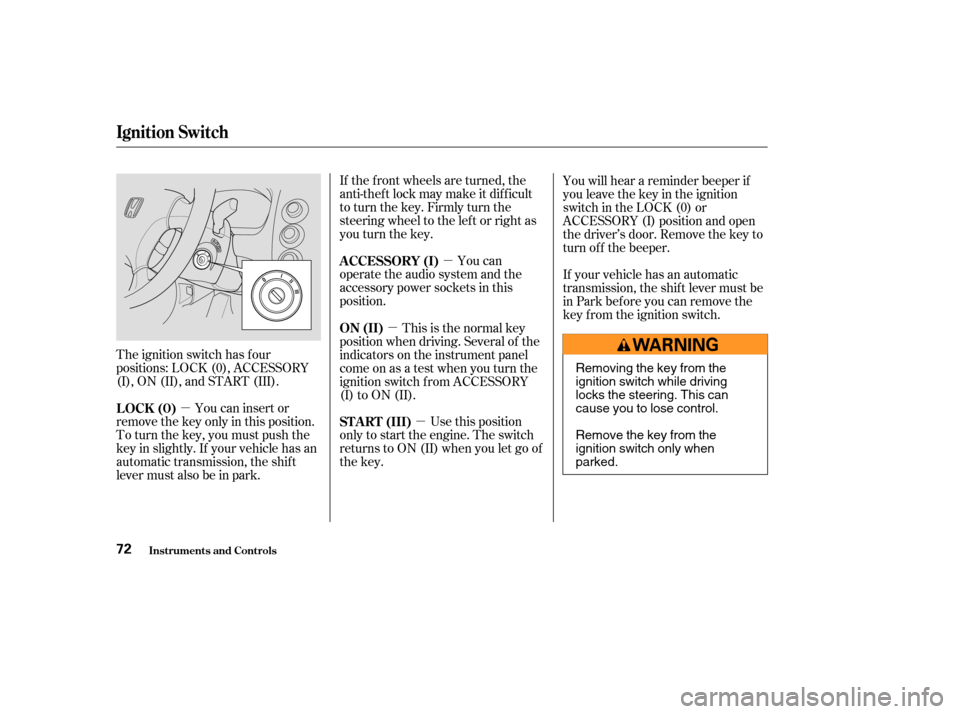Page 65 of 231

This gauge shows you the state of
charge of the battery for the
Integrated Motor Assist (IMA). This
battery is recharged by the engine,
anddischargedbytheIMAwhenit
is assisting the engine with powering
the vehicle.
The gauge reading may drop near
the bottom under driving conditions
that require assist f or a long time,
such as prolonged acceleration orclimbing a long hill. The engine will
recharge the battery as you continue
driving.
If the battery is mostly discharged,
the Auto Idle Stop f unction is
disabled (see pages and ).
The battery level gauge does not
read the battery level directly. It
calculates the level by continuously
measuring the current f low, voltage,
and temperature.
Since the level is not read directly,
small sensing errors can, over time,
cause the gauge to read higher than
the actual battery level. The system
will then perf orm a correction, and
the battery level gauge reading will
drop suddenly. When this happens,
IMA assist and Auto Idle Stop are
disabled until the IMA battery is
suf f iciently recharged by normal
driving. This should take only a f ew
minutes.This correction of the battery level
gauge is normal and does not
indicate a problem. If the IMA
battery develops a problem or
becomes deteriorated, the IMA
system indicator will come on. If this
happens, have the vehicle checked
by your dealer as soon as possible.
137
131
IMA Battery Level Gauge
Gauges
Inst rument s and Cont rols62
IMA BATTERY LEVEL GAUGE
Page 66 of 231

If the IMA battery is too hot or too
cold, the IMA system shuts down to
protect the battery. This disables the
IMA assist and Auto Idle Stop, even
though the Battery Level Gauge may
show that the battery is well-charged.
Theref ore, those f unctions may not
operate when you f irst start driving
in very hot or cold weather.This shows the temperature of the
engine’s coolant. During normal
operation, the reading should be in
the middle of the gauge. In severe
driving conditions, the reading may
reach near the red mark. If it
reaches the red (Hot) mark, pull
safely to the side of the road. Turn to
page f or instructions and
precautions on checking the engine’s
cooling system.
The battery temperature will
normalize af ter a f ew minutes of
driving, and the IMA system will
work normally.
This gauge shows you the status of
the Integrated Motor Assist (IMA).
When the IMA battery is being
charged, the lef t side of the gauge
illuminates. When the IMA is
assisting the engine, the right side of
the gauge illuminates. 187
Charge/Assist Gauge
Temperature Gauge
Gauges
Inst rument s and Cont rols63
IMA CHARGE
GAUGEIMA ASSIST
GAUGE
Page 73 of 231
Youshouldhavereceivedakey
number tag with your set of keys.
You will need this key number if you
ever have to get a key replaced. Use
only Honda-approved key blanks.These keys contain electronic
circuits that are activated by the
Immobilizer System. They will not
work to start the engine if the
circuits are damaged.
Protect the keys f rom direct
sunlight, high temperature, and
high humidity.
Donotdropthekeysorsetheavy
objects on them.
Keep the keys away f rom liquids.
If they get wet, dry them
immediately with a sof t cloth.
The keys do not contain batteries.
Do not try to take them apart.
The master key fits all the locks on
your vehicle.
The valet key works only in the
ignition and the door locks. You can
keep the trunk and trunk release
handle locked when you leave your
vehicle and the valet key at a parking
f acility.
Keys and Locks
Inst rument s and Cont rols70
MASTER
KEYS
(Black)
VALET
KEY
(Gray)
KEY
NUMBER
TAG
Page 74 of 231

The Immobilizer System protects
your vehicle f rom thef t. If an
improperly-coded key (or other
device) is used, the engine’s f uel
system is disabled.If the system repeatedly does not
recognize the coding of your key,
contact your Honda dealer.
Do not attempt to alter this system
or add other devices to it. Electrical
problems could result that may make
your vehicle undriveable.
If you have lost your key and cannot
start your engine, contact a Honda
dealer.
When you turn the ignition switch to
ON (II), the Immobilizer System
indicator should come on f or a f ew
seconds, then go out. If the indicator
starts to blink, it means the system
does not recognize the coding of the
key. Turn the ignition switch to
LOCK (0), remove the key, reinsert
it, and turn the switch to ON (II)
again.
The system may not recognize your
key’s coding if another immobilizer
key or other metal object (i.e. key
f ob) is near the ignition switch when
you insert the key.As required by the FCC:
This device complies with Part 15 of theFCC rules. Operation is subject to thef ollowing two conditions: (1) This devicemay not cause harmf ul interf erence, and(2) this device must accept anyinterf erence received, includinginterf erence that may cause undesiredoperation.
Changes or modif ications not expresslyapproved by the party responsible f orcompliance could void the user’sauthority to operate the equipment.
This device complies with IndustryCanada Standard RSS-210.Operation is subject to the f ollowing twoconditions: (1) this device may not causeinterf erence, and (2) this device mustaccept any interf erence that may causeundesired operation of the device.
Immobilizer Syst em
Inst rument s and Cont rols71
Page 75 of 231

�µ
�µ
�µ �µ
The ignition switch has f our
positions: LOCK (0), ACCESSORY
(I), ON (II), and START (III). If the f ront wheels are turned, the
anti-thef t lock may make it dif f icult
to turn the key. Firmly turn the
steering wheel to the lef t or right as
you turn the key.
You can
operate the audio system and the
accessory power sockets in this
position.
Use this position
only to start the engine. The switch
returns to ON (II) when you let go of
the key. You will hear a reminder beeper if
you leave the key in the ignition
switch in the LOCK (0) or
ACCESSORY (I) position and open
the driver’s door. Remove the key to
turn of f the beeper.
You can insert or
remove the key only in this position.
To turn the key, you must push the
key in slightly. If your vehicle has an
automatic transmission, the shif t
lever must also be in park. If your vehicle has an automatic
transmission, the shif t lever must be
in Park bef ore you can remove the
key f rom the ignition switch.
This is the normal key
position when driving. Several of the
indicators on the instrument panel
come on as a test when you turn the
ignition switch f rom ACCESSORY
(I) to ON (II). A CCESSORY (I)
ST A RT (III)
LOCK (0) ON (II)
Ignition Switch
Inst rument s and Cont rols72
Removing the key from the
ignition switch while driving
locks the steering. This can
cause you to lose control.
Remove the key from the
ignition switch only when
parked.
Page 92 of 231
CONT INUED
You can manually set the system
controls f or ventilation, air
conditioning, heating, air f low
direction, and fan speed in various
combinations.When the ECON button is on:
The indicator comes on.
The Auto Idle Stop is enabled.
The system will not cool as quickly
when the A/C is on.
If the outside temperature is below
f reezing, the Auto Idle Stop is
disabled, even if the ECON button is
on. The heater will continue to warm
the interior with the vehicle stopped
and engine running.
When the ECON button is off: The Auto Idle Stop is disabled.
The system turns of f the ECON
mode when you select or . If thefancontroldialisoff,the
ECON button will not turn on or of f ,
and the Auto Idle Stop is enabled.
Comf ort and Convenience Feat ures
Manual Operation
ECON Button
Vents, Heating, and A/C
89
Page 94 of 231

If the interior is very warm,you can
cool it down more rapidly by partially
opening the windows, turning on the
A/C, and setting the fan to
maximum speed in Fresh Air mode.
In AUTO mode, the system controls
the air f low direction automatically
between the dashboard vents and
the f loor vents.
The f low-through ventilation system
draws in outside air, circulates it
through the interior, then exhausts it
through vents near the rear side
panels.
Turn the temperature control dial
all the way to the lef t.
Make sure the A/C is of f .
Select and Fresh Air mode.
Set the f an to the desired speed.
The heater uses engine coolant to
warm the air. If the engine is cold, it
will be several minutes bef ore you
f eel warm air coming through the
system. Turn on the A/C by pressing the
button. The light in the button
comesonwhenafanspeedis
selected.
Make sure the temperature
control dial is all the way to the left.
Select .
If the outside air is humid, select
Recirculation mode. If the outside
air is dry, select Fresh Air mode.
Set the f an to the desired speed.
Air conditioning places an extra load
on the engine. Watch the engine
coolant temperature gauge (see page
). If it moves near the red zone,
turn of f the A/C until the gauge
reads normally. Select and Fresh Air mode.
Set the f an to the desired speed.
Adjust the warmth of the air with
the temperature control dial.
1.
2.
3.
4. 1.
2.
3.
4.
5. 2.
3. 1.
63
Ventilation
Using the Heater Using the A /C
Comf ort and Convenience Feat ures
Vents, Heating, and A/C
91
Page 117 of 231

Help assure your vehicle’s f uture
reliability and perf ormance by paying
extra attention to how you drive
during the f irst 600 miles (1,000 km).
During this period:Avoid full-throttle starts and rapid
acceleration.
Avoidhardbrakingforthefirst
200 miles (300 km).
Do not change the oil until the
scheduled maintenance time.
You should also f ollow these re-
commendations with an overhauled
or exchanged engine, or when the
brakes are replaced. We recommend using gasoline
containing detergent additives that
help prevent f uel system and engine
deposits.Use of gasoline with these additives
may adversely af f ect perf ormance,
and cause the Malfunction Indicator
Lamp on your instrument panel to
come on. If this happens, contact
your authorized Honda dealer f or
service.
Your Honda is designed to operate
on unleaded gasoline with a pump
octane number of 86 or higher. Use
of a lower octane gasoline can cause
occasional metallic knoking noises in
the engine and will result in
decreased engine perf ormance.
Using gasoline containing lead will
damage your vehicle’s emissions
controls. This contributes to air
pollution.
In addition, in order to maintain good
perf ormance, f uel economy, and
emissions control, we strongly
recommend, in areas where it is
available, the use of gasoline that
does NOT contain manganese-based
f uel additives such as MMT.
If you notice any undesirable
operating symptoms, try another
service station or switch to another
brand of gasoline. Some gasoline today is blended with
oxygenates such as ethanol or
MTBE. Your vehicle is designed to
operate on oxygenated gasoline
containing up to 10 percent ethanol
by volume and up to 15 percent
MTBE by volume. Do not use
gasoline containing methanol. For f urther important f uel-related
inf ormation, please ref er to your
Quick Start Guide.
Break-in Period, Gasoline T ype
Bef ore Driving
Break-in Period
Gasoline Type
114